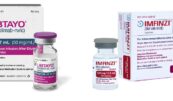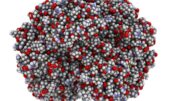Mirvetuximab soravtansine-gynx is granted accelerated approval for FRα positive, platinum-resistant epithelial ovarian, fallopian tube, or peritoneal cancer
November 2022: For adult patients who have had one to three prior systemic treatment regimens and have folate receptor alpha (FR) positive, platinum-resistant epithelial ovarian, fallopian tube, or primary peritoneal cancer, the Food and Drug Administration has given accelerated approval to mirvetuximab soravtansine-gynx (Elahere, ImmunoGen, Inc.). A microtubule inhibitor and folate receptor alpha directed antibody are combined in mirvetuximab soravtansine-gynx. A FDA-approved test is used to determine which patients will receive treatment.
The VENTANA FOLR1 (FOLR-2.1) RxDx Assay (Ventana Medical Systems, Inc.) was just given FDA approval as a companion diagnostic tool for the aforementioned indication.
Study 0417 (NCT04296890), a single-arm trial involving 106 patients with FR-positive, platinum-resistant epithelial ovarian, fallopian tube, or primary peritoneal cancer, assessed the effectiveness of treatment. Up to three preceding lines of systemic therapy were allowed for patients. Bevacizumab was a need for all patients. Patients whose tumours tested positive for FR expression using the aforementioned assay were included in the study. Patients were disqualified if they had noninfectious interstitial lung disease, Grade >1 peripheral neuropathy, corneal problems, or ocular illnesses that required continuous care.
Patients received an intravenous infusion of mirvetuximab soravtansine-gynx 6 mg/kg (based on adjusted ideal body weight) every three weeks until their condition progressed or the side effects became intolerable. Every six weeks during the first 36 weeks, and then every 12 weeks after that, tumour response evaluations were conducted.
Overall response rate (ORR) and duration of response (DOR) as determined by the investigator and measured in accordance with RECIST version 1.1 were the primary efficacy outcome measures. The confirmed ORR was 31.7% (95% CI: 22.9, 41.6) and the median DOR was 6.9 months (95% CI: 5.6, 9.7) in the efficacy evaluable sample of patients who had platinum resistant, quantifiable illness and received at least one dose (104 patients).
Vision impairment, fatigue, increased aspartate aminotransferase, nausea, increased alanine aminotransferase, keratopathy, abdominal pain, decreased lymphocytes, peripheral neuropathy, diarrhoea, decreased albumin, constipation, increased alkaline phosphatase, dry eye, decreased magnesium, decreased leukocytes, decreased neutrophils, and decreased haemoglobin were the most common (20%) adverse reactions, including laboratory abnormalities. There is a boxed warning for eye toxicity on the product label.
The suggested dose of mirvetuximab soravtansine-gynx is 6 mg/kg adjusted ideal body weight (AIBW), given intravenously once every 21 days (cycle) until disease progression or intolerable toxicity.
View full prescribing information for Elahere.
Dr. Nishant Mittal is a highly accomplished researcher with over 13 years of experience in the fields of cardiovascular biology and cancer research. His career is marked by significant contributions to stem cell biology, developmental biology, and innovative research techniques.
Research Highlights
Dr. Mittal's research has focused on several key areas:
1) Cardiovascular Development and Regeneration: He studied coronary vessel development and regeneration using zebrafish models1.
2) Cancer Biology: At Dartmouth College, he developed zebrafish models for studying tumor heterogeneity and clonal evolution in pancreatic cancer.
3) Developmental Biology: His doctoral work at Keio University involved identifying and characterizing medaka fish mutants with cardiovascular defects.
4) Stem Cell Research: He investigated the effects of folic acid on mouse embryonic stem cells and worked on cryopreservation techniques for hematopoietic stem cells.
Publications and Presentations
Dr. Mittal has authored several peer-reviewed publications in reputable journals such as Scientific Reports, Cardiovascular Research, and Disease Models & Mechanisms1. He has also presented his research at numerous international conferences, including the Stanford-Weill Cornell Cardiovascular Research Symposium and the Weinstein Cardiovascular Development Conference.
In summary, Dr. Nishant Mittal is a dedicated and accomplished researcher with a strong track record in cardiovascular and cancer biology, demonstrating expertise in various model systems and a commitment to advancing scientific knowledge through innovative research approaches.
- Comments Closed
- November 17th, 2022





mirvetuximab soravtansine-gyn
CancerFax is the most trusted online platform dedicated to connecting individuals facing advanced-stage cancer with groundbreaking cell therapies.
Send your medical reports and get a free analysis.
🌟 Join us in the fight against cancer! 🌟
Привет,
CancerFax — это самая надежная онлайн-платформа, призванная предоставить людям, столкнувшимся с раком на поздних стадиях, доступ к революционным клеточным методам лечения.
Отправьте свои медицинские заключения и получите бесплатный анализ.
🌟 Присоединяйтесь к нам в борьбе с раком! 🌟